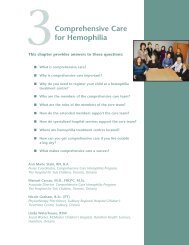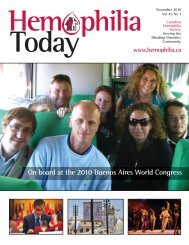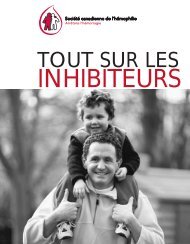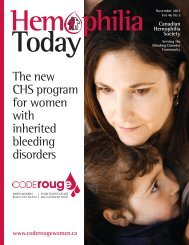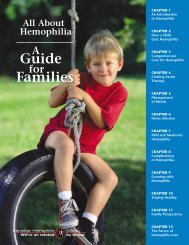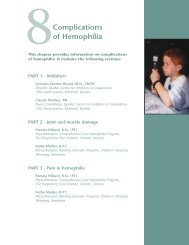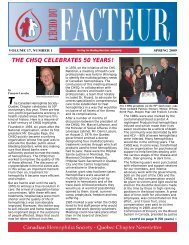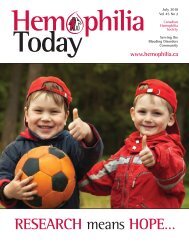Download
Download
Download
- No tags were found...
Create successful ePaper yourself
Turn your PDF publications into a flip-book with our unique Google optimized e-Paper software.
22blood factorHEMOPHILIA TODAY SUMMER 2002The Latest Findings in GeneTherapiesDavid Page,CHS Blood Safety CoordinatorThe U.S. National HemophiliaFoundation (NHF) held its FifthWorkshop on Gene Therapies forHemophilia at the Children’s Hospital ofPhiladelphia, on April 12 and 13, 2002.The workshop brought togetherresearchers from the U.S., Canada, andEurope to present their latest findings ongene therapy and bleeding disorders. Thescope of the 47 papers presented during thetwo days was very impressive.Dr. Margaret Ragni of the University ofPittsburgh Medical Center identified thechallenge for gene transfer therapy – effectivetreatment which avoids the disablingcomplications of past innovations. The idealtherapy would be effective in a single dose,would not create inhibitors, would be nontoxicand non-infectious, and would beaffordable.Ongoing trialsDr. Amy Patterson of the U.S. NationalInstitutes of Health (NIH) reported that ofthe 522 research protocols reviewed by NIH,only five were on hemophilia – three onfactor VIII and two on factor IX. All of theseare in Phase I clinical trials, during which thetherapy is tested for harmful responses with avery small number of patients. Only at PhaseII and Phase III are therapies tested for theireffectiveness in treating the target disease.Two updates on these clinical trials werepresented. Dr. Gilbert White of the Universityof North Carolina at Chapel Hill presentedthe first update on a trial which uses a guttedadenovirus vector (a modified virus used todeliver the desired gene to the proper cells inthe body) to insert the factor VIII gene intothe liver. One patient has received thisexperimental therapy with the result thatfactor VIII levels rose to 1-1.5 percent ofnormal. However, the patient developed aninflammatory response to the vector, withhigh fever and increased liver enzymes. Thistrial was placed on hold but will nowcontinue with lower doses. Another concernwith this vector is the development ofcirculating antibodies to the vector, asituation which makes repeat treatmentmuch more difficult.Dr. Bertil Glader of the StanfordUniversity Medical Center in Californiapresented an update on another clinical trial,which uses a recombinant adeno-associatedviral (rAAV) vector to deliver the factor IXgene into the liver via the hepatic artery. Hepresented early results from a Phase I clinicaltrial with two patients. Both patients receivedlow doses of the gene therapy, and liver,kidney and blood tests remained normal.Factor IX levels rose slightly to around onepercent and no inhibitors to factor IX weredetected. However, the rAAV vector wasfound in the semen of both patients.Although there is no evidence that the vectorcan be transmitted from one generation tothe next, this highlights the need to take greatprecautions against potential germlinetransmission. In the first person, traces of thevector disappeared after 10 weeks. In thesecond, it was still present after eight weeks.The next stage of the trial, in which fourpatients will receive a higher dose, will not goahead until all signs of the vector in thesemen have disappeared.These two early clinical trials representonly a fraction of the data presented at theworkshop. Participants learned of a widevariety of research using mice and dogmodels, different vectors, such as thelentivirus (a form of HIV which has beenmodified so it cannot be reproduced) anddifferent modes of delivery. Some show greatpromise while others point out potentialdangers.One case was discussed where a patient(who was not in a hemophilia trial) receiveda very low dose of the adenoviral vector anddied as a result of his body’s immuneresponse. This highlights the danger that genetherapy may carry a severe risk of toxicity at alevel that does not provide therapeuticbenefit. As one immunologist warned, “Youare working against an excruciatinglysensitive immune system designed to fightagainst just the kind of invasion you areengineering.”Alternative approachesOther presentations, however, suggestedthat genetic research with entirely differentapproaches may yield positive results.Dr. Steven Sommer of the City of HopeMedical Center in Duarte, California,described “translation bypass therapy” inwhich small-molecule drugs, taken orally, canbe used to bypass factor VIII or factor IXdeficiencies in individuals with a nonsensegene mutation – about 10 percent of peoplewith hemophilia. This holds special promisefor people in developing countries as thetreatment would be both low-cost and easy toadminister.Dr. Steven Pipe of the University ofMichigan described research in which geneticmanipulations of the factor VIII gene, eitherin the manufacturing process or in geneinsertions, could lead to benefits – increasedsecretion, longer half-life, and increasedspecific activity of factor VIII.Dr. Assem Ziady of CopernicusTherapeutics presented his work with mice inwhich the factor IX gene is transferredthrough inhalation. This approach has thebenefit of not needing a viral vector.Administration with an inhaler, a methodcommonly used by asthmatics, might havethe added benefit of a lesser immuneresponse, thus avoiding the development ofinhibitors.Dr. William Velander of the VirginiaPolytechnic Institute and State Universitypresented the most promising research, atleast for people in developing countries. Hespoke about the results of his work withtransgenic pigs that produce human factor IXin their milk The production of factor IX isso abundant that a small herd of pigs couldprovide sufficient factor IX for the entiredeveloping world. Dr. Velander hopes toachieve the same abundant level ofproduction from his factor VIII pigs withintwo years.In addition, Dr. Velander and hisassociates presented data showing that mice,when they drink pig’s milk containing humanfactor IX, absorb 10 percent into theirbloodstream. This parallels researchconducted 20 years ago in humans. Thisfinding has two possible benefits. Factortherapy could be by mouth, instead of byintravenous infusion. This would be animmense advantage for small children.What’s more, the product, taken orally from avery early age, could be used to “tolerize”small children to factor VIII and factor IX,and possibly avoid the development ofinhibitors.However, these are not today’s products.Extensive clinical trials with humans stillneed to be done and approval fromregulatory authorities needs to be obtained.As well, production facilities still have to bebuilt.It was clear from the presentations thatgene therapy treatments are still years away.Many challenges remain, but much has beenaccomplished since the NHF held its firstworkshop in 1996. The variety of researchand the innovative ingenuity exhibited by thescientists give us much reason to hope.(Reprinted with permission from the June 2002edition of Haemophilia World, the quarterlynewsletter of the World Federation ofHaemophilia)Editor’s note: Abstracts from the conference areavailable on the National HemophiliaFoundation’s web site:http://www.hemophilia.org/research/geneworkshop.htm



